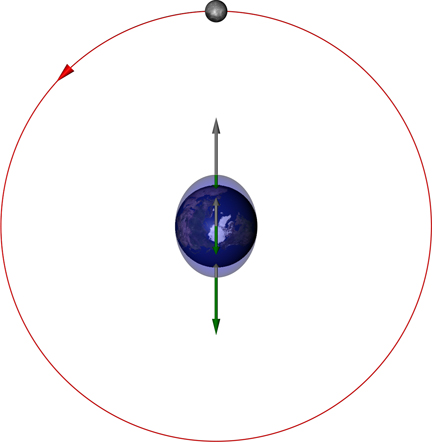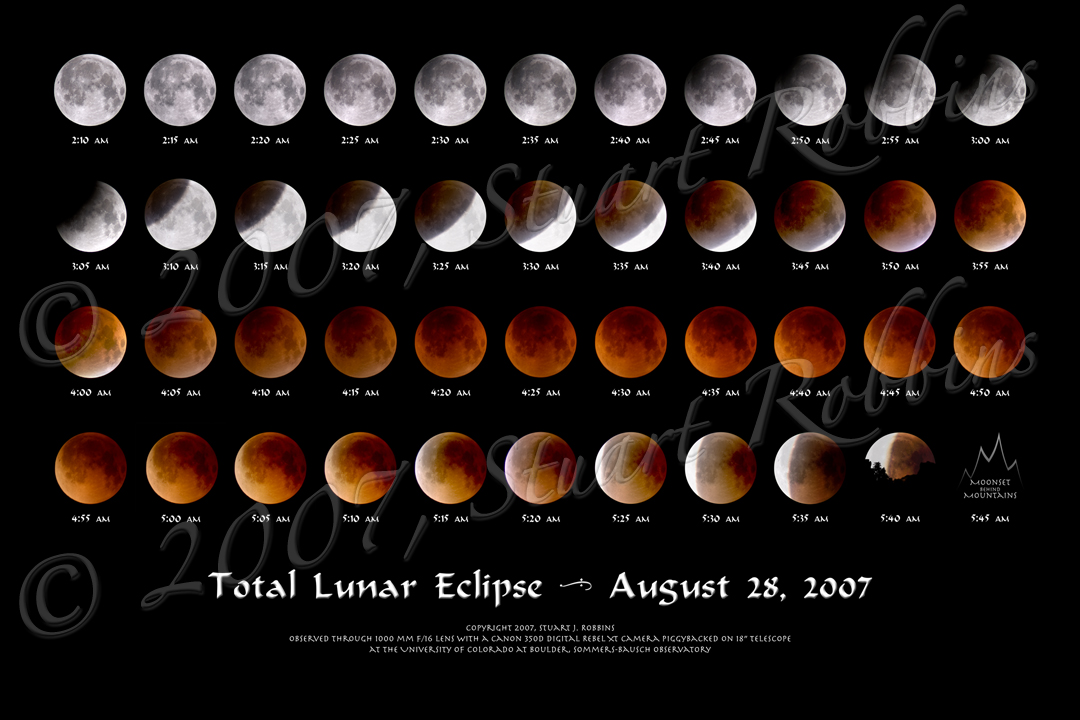Earth's Moon
Overview
The moon is Earth's closest celestial neighbor. It has major influences upon our lives, governing the tides, being responsible for eclipses, and stabilizing our planet's axial tilt. Some biologists even speculate that the moon is responsible - in part - for life on Earth, for without the large tides causing major ocean currents and mixing chemicals, life may never have formed.
The moon lies, on average, 384,400 km (238,900 miles) away and takes 27.3 days to orbit Earth (that may sound remarkably close to a calendar month). Strange as it may seem, its rotation period is exactly the same as its orbital period, something that scientists call tidally locked. Therefore, the same half is always facing Earth while the other half is always facing away (see the "Selected Features & Characteristics" section on libration, below). This mens that there isn't really a "Dark Side" of the moon.
Despite the moon being our closest celestial neighbor and it being able to brightly light our skies at night, few people have ever looked at the Earth-Moon system to-scale. The rendering below shows, to-scale in both distance and size, the Earth-Moon system, along with a small red arc to illustrate the moon's orbit (you can click on the image to see a larger version).
| The size of the Earth-Moon system completely to-scale both distance and size-wise. You can click on this image for a larger version. Image was created and rendered by Stuart Robbins; if you are an educator and you would like this image in a resolution suitable for printing, please contact me. |
Make no mistake, though, the moon by many standards is a fairly large object. No other planet in the solar system has a moon that is 1/4 the size of it (Pluto, a Dwarf Planet, has a moon Charon which is fully half as large as Pluto, but this is considered by many to be a binary planet system).
Because of its large size, the moon has had active geologic processes over time, and it is studied much like a main terrestrial (Earth-like) planet. Therefore, this page is organized much like the other pages for the planets on this site, discussing its history, interior, surface, and atmosphere. Also discussed are formation theories, selected features of interest, and phenomena such as tides and eclipses.
Note: For information on the motions of the moon through the sky and about lunar phases, please see the page "Motions and Phases of the Moon."
Observing from Earth
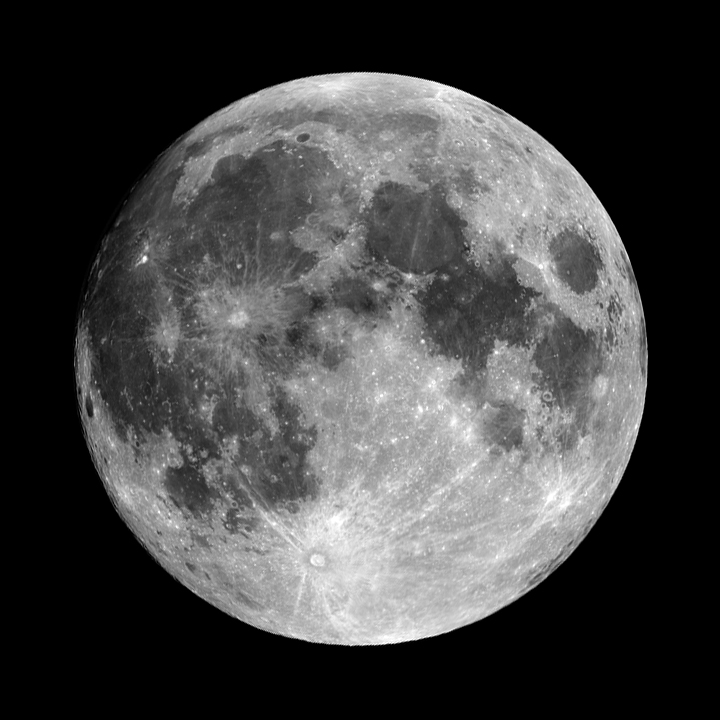 |
| A nearly-full moon, as seen from Earth. Dark mare, bright highlands, and tens of thousands of craters are visible on the near side of the moon. Photograph was taken by Stuart Robbins. |
The moon is literally the easiest celestial object to observe and to photograph from Earth. It is relatively large, occupying the same amount of sky as the sun, and it is remarkably bright - bright enough to read by when near full phase.
Besides this, the moon is actually an interesting object to observe. Rather than looking like a pale dot amidst an endless black sky, it shows a varied surface of dark volcanic basins, ancient highlands, craters from the very large to the very small, volcanic features, and different phases.
To observe the moon, just look up at it. You can begin to make out features with the naked eye. Binoculars bring these features out, and you can start to see a more varied landscape. Telescopes can make these features appear even larger, and a good place of interest to focus on is the terminator, the line between night and day. Just like early morning or evening shadows are longest on Earth, shadows are longest on the moon near the terminator, and so you can much more easily see topography like high crater walls and deep basins.
To photograph the moon, all you need is a camera with a decent zoom (or an SLR with a lens preferably 200mm or longer). I personally recommend a tripod, but it is not necessary, especially when photographing near a full moon. Basic recommended camera settings are your lowest film speed (or ISO), your lowest f/number (widest aperture), and a shutter speed of around 1/200-sec for a full moon, or 1/60-sec for a moon less than half-full. From there, you can adjust the shutter speed to be faster or slower until you get a reasonable exposure. For an in-depth guide on how to photograph the moon, geared towards lunar eclipses, click here to download the PDF (written by this site's author).
Formation
a
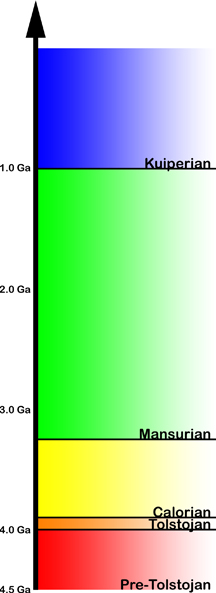 |
| Geologic history of Mercury, identifying the five major epochs identified in Mercury's history. |
Global History
Mercury is believed to be geologically dead at the present time, except for those processes required to create a magnetic field. The surface of the planet is believed to be mostly ancient, dating back at least 3 billion years, much like Earth's moon. One way to talk about Mercury is in terms of geologic ages - much like the rest of the terrestrial bodies. These are shown in the figure to the right.
These boundaries are not well established in time, unlike Earth's, because they are based upon relative dating techniques as opposed to absolute dating methods. As with Mars and Venus, Mercury's epoch ages are based upon the lunar cratering record (which has been absolutely dated from Apollo sample returns). Very briefly, this works under the assumption that the older a surface, the longer it has had to accumulate craters and so the more craters will be present. We can calibrate the cratering rate from the moon and extrapolate it to other bodies in order to estimate how many craters of a certain size should be present for a surface to be a certain age.
Geologic ages on Mercury are named after major craters (like our moon). The first is simply the Pre-Tolstojan, which covers the planet's formation ~4.5 Gya (billion years ago) until ~4.0 Gya. This covers the period from the formation of the planet, the very earliest surface, and the planet's differentiation from a homogenous mixture into a core, mantle, and crust. This time also includes most of the early Heavy Bombardment of asteroids, when most of the craters seen throughout the solar system were formed. This is likely when Mercury's intercrater plains formed.
Next is the Tolstojan period, named after the crater Tolstoy. It covers ~4.0-3.9 Gya, a fairly narrow 100 million-year period. During the Heavy Bombardment mentioned above, the crater Tolstoy formed, marking the beginning of the Tolstojan epoch. During this period, the intercrater plains continued to form.
The next geologic era is Calorian, named after Mercury's largest crater, Caloris Basin. It covers ~3.9 until 3.5-3.0 Gya (the boundary with Mansurian is not well-determined). The Caloris Basin, a large multi-ring basin on the planet, formed towards the end of the Heavy Bombardment. This basin modified the surface of the entire planet (discussed below). The Calorian period marks the time when most of the smooth plains formed on the planet, likely due to the last thrusts of volcanism before the planet cooled and solidified too much to permit volcanism.
Fourth is the Mansurian era, named after the crater Mansura. It lasts from 3.5-3.0 Gya (the boundary with Calorian is not well-determined) to ~1.0 Gya. This epoch represents light cratering and a continued decrease in planetary activity and increase in cooling. Relatively fresh craters formed during this period, but they do not have rays (because the rays have eroded since formation).
Finally is the Kuiperian age, named after the crater Kuiper. This is the youngest surface age of the planet, lasting from the end of the Mansurian ~1.0 Gya to the present day. This represents a mostly geologically dead Mercury with light cratering, the craters still posessing their rays.
Interior
a
Surface
a
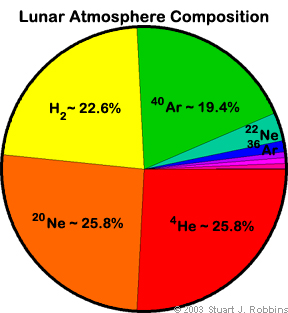 |
| A pie chart illustrating the compositional breakdown of the Moon's atmosphere. Data is from NASA's planetary factsheet. |
Atmosphere
In the conventional sense that Earth, Venus, or even Mars has an atmosphere, the moon does not. It does, however, have a very tenuous envelope of gas that surrounds it. The pressure this gas exerts on the surface is only 3·10-15 bars. To think about this in everyday life, dropping a feather on your hand would exert a pressure of about 10-3 bars, or 1 trillion times more than the moon's atmosphere.
The actual fractional values shown in the pie chart are not well constrained, and they are considered to be upper limits from the night side and variable. This is in part because the Apollo missions were not able to accurately measure the composition due to outgassing from the lunar module and experiments. After more data becomes available from later missions and observations, better values should be available.
Selected Features and Characteristics
Libration - Why We Can See More than 50% of the Surface from Earth: Note that the moon does "wobble" slightly - known as libration. The longitudinal libration (side-to-side) is a result of the moon's orbit not being a perfect circle and so moving slightly slower or faster at different points. Latitudinal libration (up-and-down) is a result of the moon's orbit being tilted relative to Earth's allowing us to peer "over" and "under" it slightly at times. Third is diurnal libration, which means that since we can see the moon both on the horizons and overhead means that we see it at slightly different vantage points. Combined, these allow us to observe about 59% of the moon's surface from Earth.
Lunar Phenomena
Tides: Tides are a complex phenomena, yet they can be boiled down to a few key concepts. The first to develop an accurate theory of the tides was Sir Isaac Newton over 300 years ago. His theory, "The Equilibrium Theory of Tides," is what will be discussed here.
First examined, will be the relationship between just the Earth and Moon. The diagram below shows a view of the Earth-Moon system (distance shrunk by 10x) with water bulges due to tidal forces.
As theorized by Newton, every object exerts a pull on every other object (Newton's Third Law). As the moon pulls on Earth, Earth also pulls on the moon. Earth is so much larger than the moon that it hardly moves at all, and the rock is so rigid that it hardly deforms at all; however, the water flows much more easily than rock. Becauseof the pull from the moon on Earth's water, the ater forms a bulge on the moon-facing side of Earth. This is a high tide.
To understand why there is a bulge on the side of Earth facing away from the moon, you need to consider the forces involved, represented by the green and gray arrows in the above diagram. Tides are caused by a gradient of forces - in other words, because the gravitational pull from the moon is different at different distances from it, the force is different which causes the tides.
This is shown by the gray arrows, representing the relative strength of the moon's pull on Earth on the moon-facing side, the center, and the side facing away from the moon. This difference shows that the far side of Earth does not feel as much of a pull from the moon. The green arrows pointing away from the moon represent the force outward. Their strength is opposite to that of the moon in direction. They are stronger on the far side of Earth and weaker on the near side.
These act to create a "net" (total) force where, on the side closer to the moon the pull is to the moon, and on the side farther from the moon the pull is away from the moon. Conversely, there is a net inward force between these two extremes, and this causes the low tides. As the moon orbits Earth, the tidal bulges move with it, making each high tide about 12 hours and 26 minutes apart.
The equation below shows the effective tidal force du to the moon (see any college-level classical mechanics textbook for its derivation, such as MaMarion & Thornton, 1995):

In this equation, D is the closest distance between Earth's surface and the moon's surface, r is the radius of Earth, and R is the distance between the moon and the point on Earth where the tide is being calculated. Due to the vectors and trigonometry, the previous qualitative explanations can thus be shown quantitatively.
Now we add the sun. The tides caused by the sun follow the exact same methods as those by the moon. Even though the sun is so much larger than Earth, it is so much farther away that the difference in the force between opposite sides of Earth is approximately 45% that of the moon's. Thus, the tides that would be produced by the sun are approximately 45% as strong as those from the moon.
One final piece will finish the Equilibrium Theory of Tides. The moon and sun do not stay at fixed points relative to Earth. The moon orbits around Earth, and Earth orbits around the sun. Therefore, the total effect of the sun and moon act to create two high and two low tides per day, but they vary in intensity. When the moon and sun are at right angles to each other, the moon's tidal effects cancel out the sun's, but as a result its pull is diminished, causing what are called "neap tides." This happens every time there is a 1st quarter or 3rd quarter moon. When the sun and moon line up relative to Earth, the two act together to create much greater high tides and much lower low tides, causing what are called "spring tides." This happens every time there is a new and full moon.
 In order to calculate the force of the sun's tide relative to the moon's, the above formulation is used, dividing the values for the sun by those of the moon. The equation boils down to that seen on the right. Using this, and then inputting the appropriate mass for the moon and the sun and the distances to both, the result comes out to approximately 45%.
In order to calculate the force of the sun's tide relative to the moon's, the above formulation is used, dividing the values for the sun by those of the moon. The equation boils down to that seen on the right. Using this, and then inputting the appropriate mass for the moon and the sun and the distances to both, the result comes out to approximately 45%.
Eclipses: Eclipses are caused by one celestial body passing in front of another - in our case, the moon pasing between the sun and Earth or Earth passing between the sun and moon. Eclipses do not occur every time there is a new or full phase of the moon. That is because the moon does not orbit in the same plane that Earth does - it is tilted by slightly more than 5°. It will cross Earth's orbital plane twice during every orbit, and if those crossing points - called "nodes" - happen to line up with a new or full phase, we will see an eclipse.
The moon, Earth, and Sun all share a present-day relationship that is unique in our solar system: As seen from Earth, the moon covers the same amount of sky as the sun. Thus, if the moon were to pass directly in front of the sun (as seen from Earth), it would block it out, causing an eclipse. This type of eclipse is called a "solar eclipse." Because it only happens when the moon passes between the sun and Earth, it can only occur during a new lunar phase. Solar eclipses can last about an hour, but "totality" - the time during which the sun is completely blocked - can only last a few minutes.
Opposite to that, a "lunar eclipse" can only happen during a full lunar phase. This is when, instead of the moon casting a shadow on Earth, Earth casts a shadow on the moon. Since Earth is much larger than the moon, Earth is much larger in the moon's sky than the sun, and so the entire moon can be eclipsed at one time, and eclipses last much longer for the moon than Earth (up to about 5 hours).
During a total lunar eclipse, the moon receives no direct light from the sun. However, Earth fortuitously has an atmosphere and this shell of gas acts like a lens, bending sunlight around Earth so that some of it will reach the moon. As the light bends through Earth's atmosphere, it gets filtered through it, and shorter wavelengths of light (bluer light) will be preferentially filtered out. What this leaves is only the longer wavelenths of light, redder light, that emerges on the other side. This is why lunar eclipses are red (and why sunsets are red, for that matter).
For both solar and lunar eclipses, there are two stages of eclipse - the penumbral and the umbral:
A good way to think about a penumbral eclipse is to look at a lightbulb and close one eye. The light is the sun, your eye is you observing on Earth, and if you hold up your finger, your finger is the moon. Now bring your finger towards the light, moving it so it just covers part of the light. That is a penumbral eclipse - part of the light source is blocked, so you are in partial shadow, but you can still get direct light from the bulb.
Now move your finger so it completely blocks the bulb. The light bulb is now completely eclipsed by your finger - you are in the umbral part of the shadow - and you experience the phase of "totality."
Past, Present, and Future Missions
The following is a list of the missions that have finished, are currently in operation, or are planned to be lanuched to explore Mercury. A brief summary is displayed, but you can click on the name of the mission to be taken to a page detailing the mission.
Mariner 10 ~ 1975-1976 ~ Mariner 10 flewby Mercury three times in 1975 and 1976. Before the first flyby, astronomers did not know the length of Mercury's day. Unfortunately, it was discovered that Mercury's day was such that during the second flyby, the following year, the spacecraft imaged nearly the same section of the planet, providing maps of only ~45% of the surface.
MESSENGER ~ 2004-present ~ MESSENGER (MErcury Surface, Space EnviroNment, GEochemistry and Ranging) became the first craft since Mariner 10 to flyby Mercury in 2008. After two subsequent flybys - October 2008 and September 2009 - it will insert itself into orbit around Mercury in March 2011 and have a nominal mission of 1 Earth year after that.
BepiColombo ~ 2013?-? ~ This is still in the planning stages. It is a joint mission between the European Space Agency (ESA) and the Japan Aerospace Exploration Agency (JAXA). It has repeatedly been scaled back and delayed due to budgetary constraints. It is currently planned to have three orbiting components that will reach Mercury in 2019 and have a 1 Earth year nominal life after that.
Data for the Moon
The following table presents selected information from NASA's planetary factsheet.
| Luna | |
|---|---|
| Perigee (106 km) | 0.3633 |
| Mean Orbital Distance (106 km) | 0.3844 |
| Apogee (106 km) | 0.4055 |
| Average Orbital Velocity (km/s) | 1.023 |
| Orbital Inclination (from Earth's orbit) | 5.145 |
| Orbital Eccentricity | 0.0549 |
| Equatorial Radius (km) | 1738.1 |
| Polar Radius (km) | 1736.0 |
| Volume (1010 km3) | 2.1958 |
| Ellipticity (variation from sphere) | 0.0012 |
| Axial Tilt (from Earth's geographic North) | 6.68° |
| Mass (1024 kg) | 0.07349 |
| Density (water=1) | 3.350 |
| Escape Velocity (km/s) | 2.38 |
| Gravity (m/s2) | 1.62 |
| Surface Pressure (bars) | ≈3·10-15 |
| Total Mass of Atmosphere (kg) | ~25,000 |
| Length of Day (hours) | 27.3217 |
| Tropical Orbital Period (days) | 29.53 |
| Bond Albedo | 0.11 |
| Visual Geometric Albedo | 0.12 |
| Visual Magnitude | +0.21 |
| Black-Body Temperature (K) | 274.5 |
| Average Surface Temperature (Celsius) | ≈-170° to +130° |
| Discoverer | Unknown |
| Discovery Date | Prehistory |
